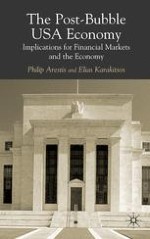2004 | OriginalPaper | Chapter
Wages and Prices and the Proper Conduct of Monetary Policy
Authors : Philip Arestis, Elias Karakitsos
Published in: The Post-Bubble US Economy
Publisher: Palgrave Macmillan UK
Included in: Professional Book Archive
Activate our intelligent search to find suitable subject content or patents.
Select sections of text to find matching patents with Artificial Intelligence. powered by
Select sections of text to find additional relevant content using AI-assisted search. powered by
Headline consumer price index-inflation (CPI-inflation) peaked at 3.7% in June 2000 and bottomed at 1.1% two years later, in June 2002. It rose steadily to 3% by March 2003 and subsided to 2% by October 2003. Core CPI-inflation, which is preferred by the Fed and taken more seriously than the headline measure in formulating monetary policy, peaked at 2.8% in November 2001 and has declined steadily to 1.3% in October 2003 (see Figure 3.1).1 Although the Fed, on numerous occasions in the last three years, has expressed fear of deflation the question arises as to what would happen to inflation now that the economy shows signs of robust growth. Is the fear of deflation justified? Or, is the Fed, as the cynics would argue, using the excuse of deflation to keep interest rates unduly low and help the personal, corporate and government sectors get rid of their debt through inflation? Would inflation remain low in the current recovery? When should the Fed tighten monetary policy, if it is to keep up with its hardly won reputation as the guardian of low inflation?
